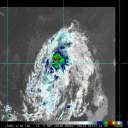Show Selection:
|
#900112 (Received by flhurricane at: 4:53 PM 27.Aug.2017)
TCDAT5
Potential Tropical Cyclone Ten Discussion Number 1
NWS National Hurricane Center Miami FL AL102017
500 PM EDT Sun Aug 27 2017
Convection associated with the broad area of low pressure located
east of the Georgia coast has increased markedly today. Visibile
satellite imagery shows multiple low-level swirls rotating around a
mean center, but ASCAT data earlier today showed that the
circulation was not yet well-defined. The ASCAT data and buoy
observations indicate that the initial intensity is 30 kt, and buoy
data suggest the central pressure is around 1007 mb. While the
system is expected to remain sheared, it has a high chance of
becoming a tropical depression or tropical storm before it becomes
baroclinic in about 48 hours. Given that, and the potential for
this system to bring tropical storm conditions to the coast from
northern South Carolina through North Carolina, advisories are
being initiated on this system as a Potential Tropical Cyclone.
The system is currently moving little in a region of weak steering,
but should begin to move slowly northward and then quickly
accelerate northeastward ahead of a mid-latitude trough moving into
the mid-Atlantic states. The NHC forecast follows the trend of the
global models keeping the low center near the coast, but as usual
there is more uncertainty than usual in the track forecast for a
weak/developing system. After the system moves into the western
Atlantic, it should continue accelerating east-northeastward ahead
of the upper trough through the end of the period.
Despite the sheared envirionment, the system should be able to
intensify a little via diabatic processes before it intensifies
further as it undergoes a more substantial baroclinic
intensification at 48 hours and beyond. The NHC intensity forecast
follows the intensity consensus through 36 hours and then follows
the trend of the global model guidance and guidance from the NOAA
Ocean Prediction Center.
Although the potential impacts are within 36 hours, given the
uncertainty in whether tropical storm force winds will occur on land
in northeastern South Caroilna and southeastern North Carolina,
south, a tropical storm watch has been issued for these areas.
Note that north of Duck, North Carolina, hazards from this system
will be handled with non-tropical products issued by local National
Weather Service offices.
FORECAST POSITIONS AND MAX WINDS
INIT 27/2100Z 31.2N 80.0W 30 KT 35 MPH...POTENTIAL TROP CYCLONE
12H 28/0600Z 31.6N 80.1W 35 KT 40 MPH...TROPICAL CYCLONE
24H 28/1800Z 32.4N 80.0W 35 KT 40 MPH
36H 29/0600Z 34.1N 78.0W 35 KT 40 MPH...INLAND
48H 29/1800Z 36.6N 75.0W 45 KT 50 MPH...POST-TROPICAL
72H 30/1800Z 40.0N 66.0W 55 KT 65 MPH...POST-TROP/EXTRATROP
96H 31/1800Z 43.0N 55.0W 60 KT 70 MPH...POST-TROP/EXTRATROP
120H 01/1800Z 47.0N 43.0W 50 KT 60 MPH...POST-TROP/EXTRATROP
$$
Forecaster Brennan |



